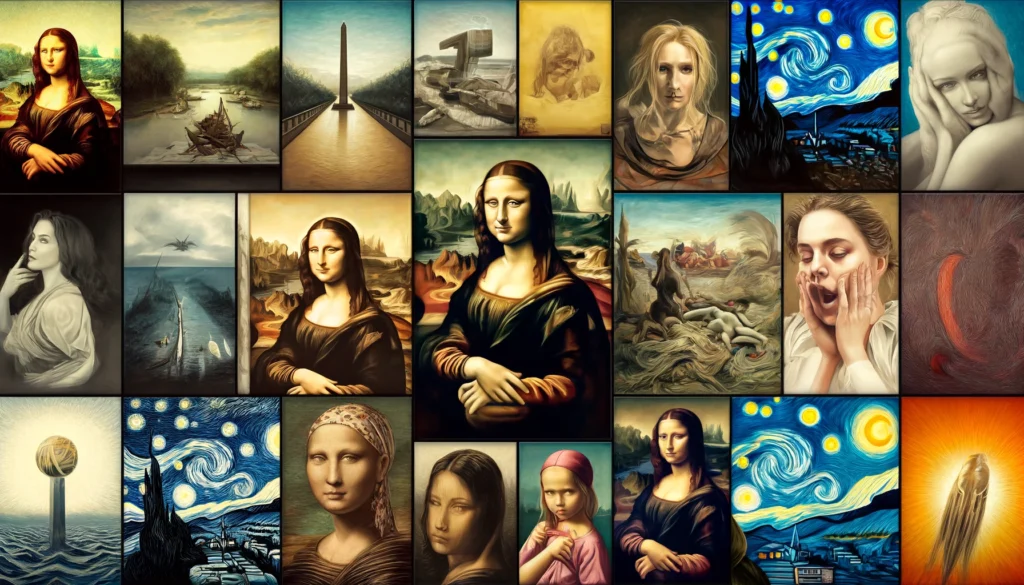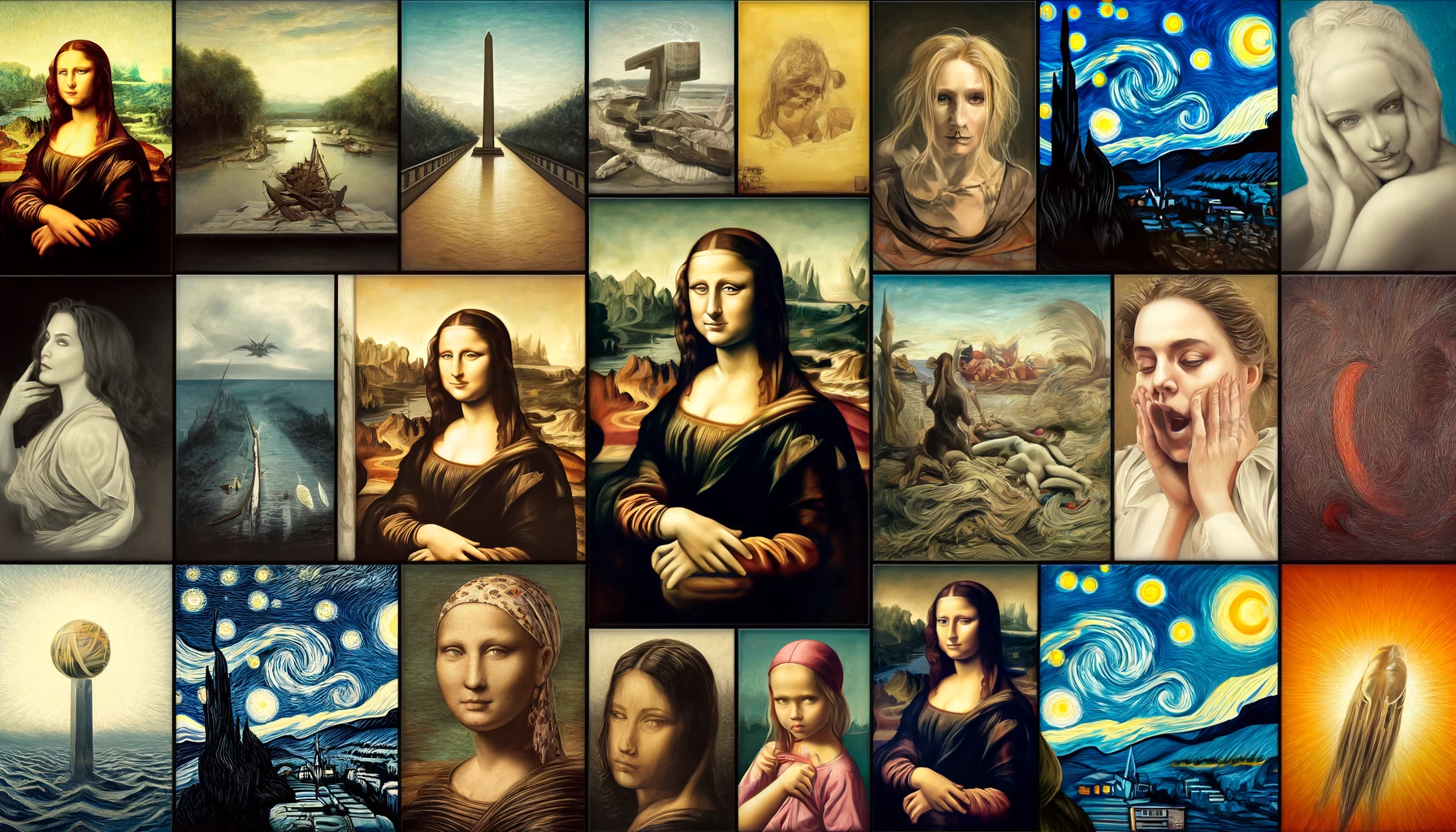Famous Artwork
Art has always been a window into the soul of humanity, capturing moments of beauty, sorrow, triumph, and contemplation. Throughout history, certain works have stood out, transcending time and culture to be hailed as masterpieces. These artworks not only reflect the skill of their creators but also offer a glimpse into the periods in which they were made, resonating with audiences centuries later. In this article, we’ll unveil some of these famous masterpieces, exploring the stories behind their creation and their lasting impact on the art world and beyond.
The Mona Lisa by Leonardo da Vinci
Arguably the most famous painting in the world, Leonardo da Vinci’s Mona Lisa, has intrigued and captivated viewers for over 500 years. Housed in the Louvre Museum in Paris, this portrait of Lisa Gherardini, the wife of a Florentine merchant, is renowned for its enigmatic expression and masterful use of sfumato. This technique creates a soft, gradual transition between colors and tones.
Da Vinci’s meticulous attention to detail and innovative approach to portraiture set the Mona Lisa apart from its contemporaries. The subject’s lifelike presence, with her slight smile and direct gaze, continues to spark debate and fascination. Whether seen as a depiction of ideal beauty or a psychological enigma, the Mona Lisa remains a pinnacle of Renaissance art and a testament to Leonardo’s genius.
The Starry Night by Vincent van Gogh
Vincent van Gogh’s The Starry Night is a vibrant and emotional depiction of a night sky swirling with energy and color. Painted in 1889 during Van Gogh’s stay at the Saint-Paul-de-Mausole asylum in Saint-Rémy-de-Provence, France, this masterpiece reflects the artist’s turbulent state of mind and unique vision.
The swirling patterns of the sky, the glowing crescent moon, and the tranquil village below create a dynamic contrast that draws viewers into Van Gogh’s world. The bold use of color and expressive brushstrokes convey a sense of movement and intensity, making The Starry Night a quintessential example of Post-Impressionism. Today, it is one of the most recognized and celebrated paintings globally, symbolizing the enduring power of artistic expression.
The Persistence of Memory by Salvador Dalí
Salvador Dalí’s The Persistence of Memory is a surreal exploration of time and reality, featuring melting clocks draped over a barren landscape. Created in 1931, this iconic work is a hallmark of the Surrealist movement, which sought to unlock the subconscious mind and challenge conventional perceptions of reality.
Dalí’s dreamlike imagery, combined with meticulous detail, creates a haunting and thought-provoking composition. The melting clocks are often interpreted as a commentary on the fluidity of time and the fragility of human experience. The Persistence of Memory continues to captivate audiences with its enigmatic symbolism and imaginative power, solidifying Dalí’s reputation as a master of surrealism.
Guernica by Pablo Picasso
Pablo Picasso’s Guernica is a powerful political statement and a stark portrayal of the horrors of war. Painted in 1937 in response to the bombing of the Basque town of Guernica during the Spanish Civil War, this monumental black-and-white mural captures the anguish and suffering of innocent civilians.
Picasso’s fragmented and distorted figures, combined with stark contrasts of light and shadow, create a sense of chaos and devastation. Guernica is not only a masterpiece of modern art but also a timeless reminder of the brutality of war and the resilience of the human spirit. Displayed at the Museo Reina Sofía in Madrid, it remains a potent symbol of anti-war sentiment and artistic activism.
The Birth of Venus by Sandro Botticelli
Sandro Botticelli’s The Birth of Venus is a celebration of beauty and classical mythology, depicting the goddess Venus emerging from the sea on a shell. Painted in the mid-1480s, this iconic work is a prime example of Italian Renaissance art, characterized by its graceful composition and harmonious proportions.
The ethereal quality of Venus, with her flowing hair and delicate features, embodies the Renaissance ideals of beauty and humanism. Botticelli’s use of soft lines and pastel colors creates a sense of tranquility and elegance, making The Birth of Venus a timeless representation of mythological beauty. Today, it is one of the most beloved artworks in the Uffizi Gallery in Florence.
Girl with a Pearl Earring by Johannes Vermeer
Often referred to as the “Mona Lisa of the North,” Johannes Vermeer’s Girl with a Pearl Earring is a captivating portrait that has enchanted viewers for centuries. Painted around 1665, this work is notable for its intimate and realistic depiction of a young girl wearing an exotic dress and a large pearl earring.
Vermeer’s masterful use of light and shadow, combined with his ability to capture subtle expressions, gives the painting a lifelike quality that feels almost photographic. The girl’s direct gaze and enigmatic smile invite viewers to ponder her story and the identity of the artist’s muse. Girl with a Pearl Earring remains a highlight of Dutch Golden Age painting and a beloved treasure of the Mauritshuis in The Hague.
The Scream by Edvard Munch
Edvard Munch’s The Scream is an iconic representation of existential angst and modern anxiety. Created in 1893, this work is part of a series titled “The Frieze of Life,” which explores themes of love, fear, and death. The painting depicts a figure standing on a bridge, clutching their face in a gesture of despair, set against a swirling, vibrant sky.
Munch’s use of bold colors and distorted forms conveys a sense of emotional intensity and psychological turmoil. The Scream’s haunting imagery has resonated with audiences worldwide, becoming a symbol of the human condition and the complexities of modern life. Today, it is housed in the National Gallery and the Munch Museum in Oslo, Norway.

Conclusion
These masterpieces, each unique in style and substance, offer a window into the diverse world of art and its profound impact on society. From the enigmatic smile of the Mona Lisa to the turbulent skies of The Starry Night, these works continue to inspire and captivate, reminding us of the timeless power of creativity and human expression. As you explore these iconic artworks, please take a moment to appreciate the stories they tell and the emotions they evoke, for they are truly the treasures of our cultural heritage.
The Enduring Appeal of Art Masterpieces
Art masterpieces have an enduring appeal that transcends time and geography, captivating audiences with their beauty, complexity, and emotional depth. Whether it’s the serene smile of Leonardo da Vinci’s Mona Lisa, the vibrant energy of Vincent van Gogh’s The Starry Night, or the surreal dreamscape of Salvador Dalí’s The Persistence of Memory, these works resonate with viewers on a profound level. They not only showcase the skill and creativity of their creators but also reflect the cultural and historical contexts in which they were made.
One of the reasons these artworks remain relevant is their ability to evoke a wide range of emotions and provoke thought. For example, The Scream by Edvard Munch captures the universal feeling of existential dread, while Pablo Picasso’s Guernica stands as a powerful anti-war statement. These masterpieces also serve as valuable educational tools, offering insights into different art movements, such as Renaissance, Impressionism, and Surrealism.
Furthermore, the accessibility of these artworks through museums, galleries, and digital platforms ensures that they continue to reach and inspire new generations of art lovers. As you delve into the world of famous art masterpieces, you’ll find that each piece has its own story to tell, inviting you to explore the depths of human creativity and expression.

